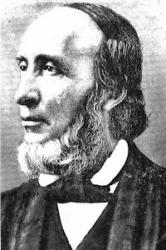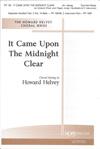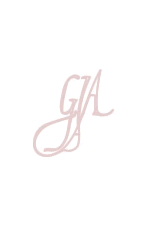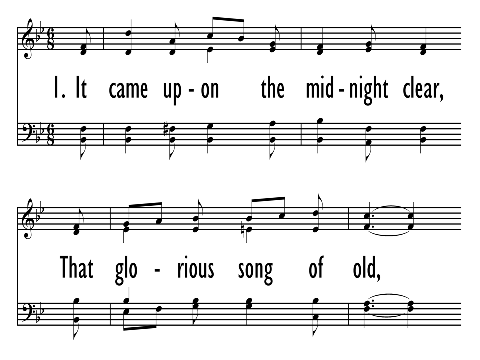- |
User Links
It Came Upon the Midnight Clear

It came upon the midnight clear
Author: Edmund H. Sears (1849)Tune: CAROL (Willis)
Published in 876 hymnals
Printable scores: PDFPlayable presentation: Lyrics only, lyrics + musicAudio files: MIDI, Recording
Representative Text
1 It came upon the midnight clear,
that glorious song of old,
from angels bending near the earth
to touch their harps of gold:
"Peace on the earth, good will to men,
from heaven's all-gracious King."
The world in solemn stillness lay,
to hear the angels sing.
2 Still through the cloven skies they come
with peaceful wings unfurled,
and still their heavenly music floats
o'er all the weary world;
above its sad and lowly plains,
they bend on hovering wing,
and ever o'er its Babel sounds
the blessed angels sing.
3 And ye, beneath life's crushing load,
whose forms are bending low,
who toil along the climbing way
with painful steps and slow,
look now! for glad and golden hours
come swiftly on the wing.
O rest beside the weary road,
and hear the angels sing!
4 For lo! the days are hastening on,
by prophet seen of old,
when with the ever-circling years
shall come the time foretold
when peace shall over all the earth
its ancient splendors fling,
and the whole world send back the song
which now the angels sing.
United Methodist Hymnal, 1989
Author: Edmund H. Sears
 Edmund Hamilton Sears was born in Berkshire [County], Massachusetts, in 1810; graduated at Union College, Schenectady, in 1834, and at the Theological School of Harvard University, in 1837. He became pastor of the Unitarian Society in Wayland, Mass., in 1838; removed to Lancaster in 1840; but on account of ill health was obliged to retire from the active duties of the ministry in 1847; since then, residing in Wayland, he devoted himself to literature. He has published several works.
--Annotations of the Hymnal, Charles Hutchins, M.A., 1872… Go to person page >
Edmund Hamilton Sears was born in Berkshire [County], Massachusetts, in 1810; graduated at Union College, Schenectady, in 1834, and at the Theological School of Harvard University, in 1837. He became pastor of the Unitarian Society in Wayland, Mass., in 1838; removed to Lancaster in 1840; but on account of ill health was obliged to retire from the active duties of the ministry in 1847; since then, residing in Wayland, he devoted himself to literature. He has published several works.
--Annotations of the Hymnal, Charles Hutchins, M.A., 1872… Go to person page >Text Information
Related Texts
| First Line: | It came upon the midnight clear |
| Title: | It Came Upon the Midnight Clear |
| Author: | Edmund H. Sears (1849) |
| Meter: | 8.6.8.6 D |
| Language: | English |
| Notes: | Spanish translations: See "A medionoche resonó" by José L. Santiago Cabrera, "A media noche en Bethlehem" by George Paul Simmonds |
| Copyright: | Public Domain |
- Year A, Christmas season, Christmas Eve
This is recommended for Year A, Christmas season, Christmas Eve by 4 hymnal lectionary indexes including Glory to God: the Presbyterian Hymnal #123. - Year A, Christmas season, Christmas Eve
- Year B, Christmas season, Christmas Eve
This is recommended for Year B, Christmas season, Christmas Eve by 2 hymnal lectionary indexes including Glory to God: the Presbyterian Hymnal #123. - Year B, Christmas season, Christmas Eve
- Year C, Christmas season, Christmas Eve
This is recommended for Year C, Christmas season, Christmas Eve by 2 hymnal lectionary indexes including Glory to God: the Presbyterian Hymnal #123. - Year C, Christmas season, Christmas Eve
- Year C, Christmas season, Christmas Day
This is recommended for Year C, Christmas season, Christmas Day by 2 hymnal lectionary indexes including Glory to God: the Presbyterian Hymnal #123.
English
- A Book of Song and Service: for Sunday school and home #157
- A Church of England Hymn Book: adapted to the daily services of the Church throughout the year #292
- A Handy Book of Old and Familiar Hymns #47
- A Hymnal and Service Book for Sunday Schools, Day Schools, Guilds, Brotherhoods, etc. #170
- A Hymnal for Friends #159
- A Hymnal for Joyous Youth: An all-purpose hymnal for church, young peoples' services and Sunday schools #57
- A Junior Hymnal with Song Stories and Worship Programs #d38
- A Junior's Praise #91
- A Manual of Worship: for the chapel of Girard College #266
- A Missionary Hymn Book #190 10 shown out of 642
German
Spanish
Tune
CAROL (Willis)NOEL (Sullivan)
The tune NOEL (also used at 185) is also known as EARDISLEY or GERARD. Arthur Seymour Sullivan (b Lambeth, London. England. 1842; d. Westminster, London, 1900) adapted this traditional English melody (probably one of the variants of the folk song "Dives and Lazarus"), added phrases of his own to rec…
For Leaders
Text:
Edmund H. Sears, a Unitarian minister at Wayland, Massachusetts, wrote this hymn in 1849. It was published that year a few days after Christmas in the Boston Christian Register. While obviously a Christmas hymn due to its theme of the angels' song, there is no mention at all of Christ or His birth about which the angels sang; it is a social gospel hymn. Perhaps this is due to the theological leanings of its author, even though Sears believed in the divinity of Christ, contrary to most Unitarians. Written only a dozen years before the outbreak of the American Civil War, the peaceable leanings of the Unitarian school of thought are evident in the text.
Originally written in five stanzas, this hymn is usually published with four. The third stanza (beginning “Yet with the woes”) is most commonly omitted, and the fourth (beginning “And ye, beneath life's crushing load”) is next most common. The first and second stanzas (“It came upon the midnight clear” and “Still through the cloven skies they come”) describe the coming of the angels and their song. The third condemns war, and the fourth commiserates with those in bondage and trial. The fifth stanza (“For lo! the days are hastening on”) describes a future time of peace.
Tune:
CAROL is the most common tune to which this hymn is sung. It comes from the twenty-third study in Church Chorals and Choir Studies of 1850 by Richard Willis. The composer later arranged the tune into its present form for the Christmas text “While Shepherds Watched Their Flocks.” CAROL was first paired with “It Came Upon a Midnight Clear” in 1878.
This tune may be sung in harmony, or in unison. The accompaniment should be legato, and an additional instrument such as a flute or violin would work well.
When/Why/How:
This hymn is suitable for the Christmas season. Such a well-known hymn can be used in a variety of ways. Settings of CAROL suitable for prelude, offertory, or postlude can be found in collections such as “Christmas Comes Again, Set 2” for organ or “Christmas Carols at the Piano.” A flexible medley for four-hands piano with three other well-known carols is part of “A Season of Joy.” “The Midnight Clear” is a setting of Sears's text to original music by Joel Raney suitable for a choral anthem. The accompaniment can be expanded beyond the flowing piano part with parts for optional flute, oboe, cello, and handbells. The collection “Tis the Season” contains a descant and congregational setting of this hymn. Another congregational setting of “It Came Upon the Midnight Clear” includes a trumpet descant.
Tiffany Shomsky, Hymnary.org
Timeline
Arrangements
Media
The United Methodist Hymnal #218
- MIDI file from Baptist Hymnal 1991 #93
- MIDI file from Baptist Hymnal 1991 #93
- Audio recording from Baptist Hymnal 2008 #188
- MIDI file from The Cyber Hymnal #3085
- Audio recording from Evangelical Lutheran Worship #282
- Audio recording from Glory to God: the Presbyterian Hymnal #123
- MIDI file from Northfield Hymnal No. 2 #42
- Audio recording from Trinity Hymnal (Rev. ed.) #200
- MIDI file from Timeless Truths #912
- Audio recording from The Worshiping Church #170
- MIDI file from The United Methodist Hymnal #218
- Audio recording from The United Methodist Hymnal #218
- MIDI file from Worship and Rejoice #191
- Audio recording from Worship (4th ed.) #419


 My Starred Hymns
My Starred Hymns







